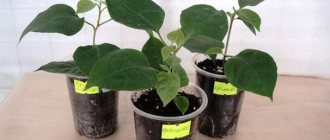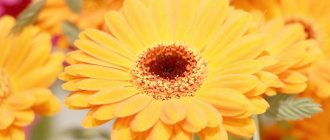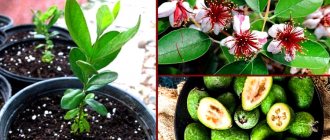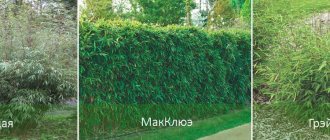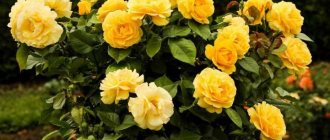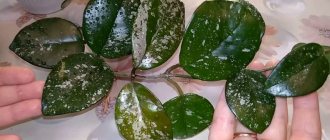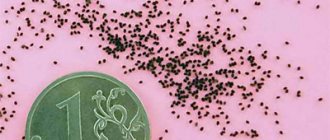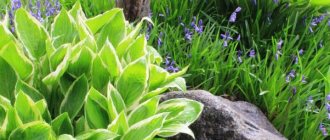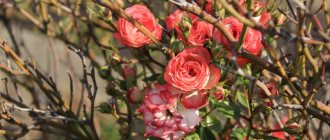Getting to know bougainvillea
Bougainvillea is a tropical plant that is named after the navigator Louis Antoine de Bougainville, who was the leader of a round-the-world expedition with the participation of the famous biologist Kimmerson, and he brought this plant to Europe.
Bougainvillea is native to South America, where it can grow as a vine, small tree or shrub with creeping stems that cling to the surface.
The shoots have spines with which they hold onto supports. Characterized by rapid growth. The average shoot length is about 5 meters. Under our climatic conditions, bougainvillea can only be grown at home or in heated greenhouses. The plant has rounded green leaves with sharp ends up to 8 cm long. The flowers are tubular, light yellow, small in size, and inconspicuous in appearance. The aesthetic appearance of the bush is achieved thanks to the bracts, which have a colorful appearance and a colorful paper texture. They can have different shapes and colors. The shape can be round, triangular or heart-shaped. The length varies from three to five centimeters. The color can be lilac, snow-white, lilac, orange, bright red or pink. Newly introduced bougainvillea varieties may have purple or bicolor bracts that change over time.
Despite the inconspicuous appearance and rapid fading of the flowers, the bracts decorate the plant for a long time. When growing bougainvillea indoors, flowering begins in May and continues until November.
Description of the plant
This exotic beauty is difficult to confuse with other representatives. It is distinguished by its unusually lush appearance and beautiful bracts, which are often mistaken for the main flowers.
The leaves are oval in shape, with a pointed end. Their color is bright green, and on the reverse side, the leaf is much lighter. The main flowers are small in size and pale yellow in color.
Know. These shrubs have become famous for their bracts, which are found in the shape of hearts, triangles, and sometimes round.
Due to the unusual bracts, bougainvillea received the name paper flower, since they look as if they were created from crumpled paper. Bracts decorate the bush for a very long time. As for primary colors, they fade and fade quickly.
It is also important that the exotic beauty, growing at home, blooms from May to November. Having once seen this gorgeous bush, every gardener admits that bougainvillea has won his heart forever.
Planting bougainvillea at home
Bushes should be planted in pots up to 5 liters. The larger the volume of the pot, the worse the flowering, since indoor bougainvillea begins to actively form leaves without forming buds. The soil for planting can be prepared independently or purchased at garden stores. To prepare the soil, mix coarse sand, leaf soil and turf in equal proportions, add a little expanded clay or broken brick. The soil must be nutritious and moisture-absorbing. The acidity is neutral or weak. A prerequisite for planting is to place a drainage layer at the bottom of the pot. The larger the volume of the container, the thicker the drainage layer should be.
How often should Bougainvillea be watered?
Water the plant generously during vigorous growth, which occurs in spring and summer. The soil mixture should be slightly moist (not soggy) at all times. Watering is carried out immediately after the top layer of the substrate is half dry. On average, watering is carried out 1-2 times every 7 days.
Interesting materials:
How many meters are in one degree of longitude? How many microsieverts is normal? How many milliliters are in one tablespoon of oil? How long do you need to wear braces at least? How many minutes and how many seconds is a quarter of an hour? How many minutes does a TV advertisement last? How many minutes is the break between periods in hockey? How many minutes does it take to heat the soil in the oven? How many minutes are there in three quarters of an hour? How many minute breaks are there in basketball?
Growing and caring for bougainvillea
Bougainvillea belongs to the Radiaceae family and has a total of 15 varieties, but only a few of them can be grown at home. Among them are bougainvillea glabra and bougainvillea remarkable. Since it is a tropical plant, it is grown in well-lit areas with plenty of open space. It is quite difficult to get beautiful bougainvillea at home, since it needs to be grown at a certain humidity and air temperature. In greenhouses, the tree is grown in large containers placed on the south side. Bougainvillea is best grown at home on glazed balconies, where the temperature can be maintained within 10 degrees in winter.
Indoors, choose a place where your indoor bougainvillea will receive sunbathing for at least five hours. This is one of the most necessary conditions for normal flowering and growth of the bush. If the pot with it is in a shaded place and receives insufficient light, its shoots grow thin and long, the leaves are pale, and flowering rarely occurs. It should also be taken into account that the tree is afraid of drafts and cold air currents. In summer, you can place pots with plants on an open balcony, protected from the wind.
Bougainvillea is fertilized once every two weeks, alternating mineral fertilizers with organic ones. During the period of active vegetative growth, which begins in May, the flower is fertilized with phosphorus-potassium fertilizers. In winter, the plant is not fertilized or sprayed.
Much attention should be paid to watering the flower. In summer, this is done once or twice a week, when the top layer of soil has dried to the thickness of half a phalanx of a finger. The pot must have a drainage layer, as the plant is sensitive to stagnation of water. The water that collects in the pan after moistening must be drained, as it provokes rotting of the roots and death of the plant.
In winter, indoor bougainvillea is watered once every two weeks. The lower the temperature in the room, the less often you water.
Bougainvillea
Bougainvillea is an unusually beautiful shrub native to Brazil. It is a favorite decoration for apartments and greenhouses. Beginning flower growers are interested in everything about the bougainvillea plant, care at home, features of cultivation and all existing varieties and species.
Most experienced flower growers claim that bougainvillea is the most luxurious and beautiful plant. If this judgment is very widespread, then it’s time to get to know this exotic beauty better and learn more about the representative originally from Brazil.
Replanting bougainvillea
Transplantation is done once every 5 years to rejuvenate old bushes and once every 2 years to activate growth in young bushes. This procedure is carried out in the spring before flowering begins. When transplanting, transfer the root system along with a lump of earth into a larger pot. Two fingers should be placed between the edge of the earthen ball and the wall of the new pot. The empty space is filled with fresh soil mixture.
Bougainvillea slowly gets used to its new location at home, so moving it from place to place is not recommended. In this case, it can throw off buds and leaves.
But if the growing conditions in the new mass are better, it grows new green mass and after some time begins to bloom profusely. The active growing season occurs in spring and autumn. During this period, the temperature in the room should be around 22-25 degrees. It is recommended to moisten the leaves from the sprayer with sifted soft water so that it does not fall on the bracts.
Bougainvillea does not bloom, what should I do?
Sometimes, bougainvillea lovers may notice that their favorite plant does not bloom. This change could be caused by the following:
- The plant was moved from open air to a room, and there was a sharp change in location and temperature.
- The flower was just purchased in a store and has not yet had time to adapt to the new environment.
- There has been a seasonal change in temperature indicators.
- Transplanting the plant into a larger pot. As soon as the root grows, the flower will bloom.
- Incorrectly organized period of rest or its absence at all. The plant needs to be given rest.
- Cool and rainy weather in summer. You need to remove the bush from a damp and cool place.
When all recommendations for growing are followed, the flower quickly adapts to new living conditions and soon begins to delight all household members with flowering.
Keeping bougainvillea in winter
In winter, bougainvillea requires special care. This is due to the fact that the duration of daylight hours decreases sharply and the plant begins to feel a lack of lighting. In winter, indoor bougainvillea needs to create rest. Move the bougainvillea pot to a well-lit, cool place with a temperature of about 5-10 degrees and stop watering. At temperatures above this, the plant will not go dormant, but will continue to grow and bloom. However, this will greatly deplete it and make it weak, which will negatively affect flowering in the spring. With the onset of warmth and increasing daylight hours, the temperature of the room is gradually increased, and watering is done more often.
Diseases and pests, how to treat
Bougainvillea easily tolerates diseases, provided it is well cared for. Often the flower begins to hurt due to excessive watering, which leads to stagnation of water in the pot. Then the plant reacts by yellowing the leaves, but when the cause is removed, the flower again begins to delight the gardener’s eyes.
Bougainvillea is susceptible to the following pests. Aphids, mealybugs and spider mites. To identify parasites in time, you need to regularly inspect the plant. If pests are found, they should be destroyed using special means designed for such manipulations. You can buy them at any flower shop.
To ensure that parasites no longer disturb the plant, you need to regularly remove dust from them. These manipulations will help protect the exotic beauty from trouble.
Propagation of bougainvillea at home
Bougainvillea can be propagated in two ways: cuttings or layering.
- Propagation by cuttings. If you want to carry out cuttings in the spring, cuttings taken from the tops of branches after cutting are suitable for this. They should be cut into ten-centimeter pieces. In summer, cuttings are cut separately. In such a way that the lower cut is as low as possible under the lower bud. The leaves are torn off to the middle. The cuttings are placed in a solution with a rooting agent for several hours. The pots are filled with finely chopped sphagnum moss, coal and sand. The cuttings are placed in this substrate up to the second internode at an angle of 45 degrees, covered with film or placed in a greenhouse, creating a temperature for rooting of 21-23 degrees. During the rooting process, high humidity, diffused light and average soil moisture should be maintained. The seedlings are periodically sprayed and ventilated.
- Reproduction by layering. This method is most often used in greenhouses on plants with large pots. Long stems are cut in a circle and pressed to the ground with wire or wooden brackets, covered with a layer of fertile soil on top and moistened. After some time, new stems emerge from the axillary buds, which develop an independent root system. After the shoot becomes strong, it is cut off from the mother plant with pruning shears and planted in a permanent place.
Features of growing bougainvillea at home - from planting to pruning
The beautiful bougainvillea is an evergreen shrub of the Niktaginov family, named after the French navigator Louis Antoine De Bougainville, who brought the plant from the hills of Rio de Janeiro to France.
Many people believe that bougainvillea grows and reproduces at home extremely difficult, and caring for it causes a lot of trouble, but this is not so. With a little effort and having studied all the intricacies of propagation, planting and care, you can admire the luxurious clusters even on the windowsills of residential apartments.
- Briefly about the beautiful bougainvillea
- Temperature and lighting requirements
- Watering and proper fertilization
- Rules and features of transplantation
- Reproduction at home
- Technique for forming a beautiful bush
Briefly about the beautiful bougainvillea
Bougainvillea includes approximately 15 species of beautiful flowering shrubs in its genus. Tree branches have thorns. Breeders have managed to develop varieties for home floriculture that have very few thorns, but it is not yet possible to completely get rid of them.
Bougainvillea flowers are not at all remarkable, small, vanilla-white, hidden in the depths of three bracts - they surprise with their beauty and create the illusion of bright large flower heads. In nature, bracts range from pink to purple, and the work of breeders has made it possible to grow bougainvillea with bracts of white, yellow, orange, brick and other colors.
Temperature and lighting requirements
Bougainvillea is accustomed to a subtropical climate, therefore, one of the most important conditions for growing at home is to ensure the required temperature conditions. During the period of active growth and flowering, the daily temperature is desirable within 25-30 degrees. Night - not lower than 20 degrees.
Important : temperatures above 42 degrees have a negative effect on the plant, causing it to wilt and drop leaves and flowers.
For the dormant period, it is desirable to ensure the ambient temperature is within 10-15 degrees, but a warm winter with a temperature of 15 to 20 degrees is also allowed.
Growing bougainvillea at home requires the maximum amount of light, so southern windows are suitable. She is not afraid of direct sunlight and can grow without shading. When placed on northern or western windows, the plant needs additional lighting; without it, the vine will not bloom.
Watering and proper fertilization
Bougainvillea is very demanding when it comes to watering. During the growing season and flowering, it should be watered abundantly with settled water at room temperature, avoiding moisture retention. With insufficient watering, if even a short-term drying out of the earthen clod occurs, the plant begins to shed leaves and flowers. In winter, watering is reduced, watering as the earthen clod dries out by half.
When growing bougainvillea at home, fertilizing is carried out in the spring and summer: starting in April and stopping in September. Use complex fertilizer or compounds for beautifully flowering indoor plants. The optimal content of nitrogen, potassium and phosphorus is 20-20-20. The frequency of feeding is once every 3 weeks.
Rules and features of transplantation
Young plants are transplanted annually at the beginning of spring into pots larger in diameter than the previous ones by 2-3 cm. After reaching the age of three, replanting is carried out every 2-3 years.
Choose a glazed ceramic pot with a mandatory drainage hole. It has been noticed that bougainvilleas feel worse in plastic pots and grow more slowly. At least 3 cm of drainage is poured onto the bottom.
The soil for planting should be slightly acidic or neutral. It should be remembered that in a slightly acidic environment (pH = 6.5) the content of phosphorus and other microelements is optimal for the plant, and with such a soil reaction, they are in an accessible form for the root system.
The composition of the soil should ensure good air exchange. When choosing a ready-made mixture, you should give preference to soil for flowering plants, adding 20% perlite or vermiculite. You can independently prepare the soil for planting bougainvillea by mixing turf and leaf soil, humus and sand in the ratio 2:2:1:1.
Reproduction at home
Most often, the vegetative method is used to propagate bougainvillea at home - with young green cuttings (from June to August) or semi-lignified cuttings (from March to May).
- Using a sharp knife, cut cuttings from the middle part of the shoot 10-15 cm long. The upper cut is horizontal, the lower cut is at an angle of 45 degrees.
- From the lower cut side, leaves are removed to 2/3 of the height.
- The cutting is placed in a root formation stimulator for the time specified by the manufacturer.
- The prepared cuttings are buried 5 cm in the soil for rooting. The soil for this is prepared as follows: mix leaf soil and perlite in a ratio of 2:1, then steam the mixture in the oven for 10 minutes or in the microwave for 5 minutes at maximum power and pour into plastic cups with perforated bottoms.
- After planting, the cuttings are watered with warm, settled water and covered with a cap from a plastic bottle or a plastic bag.
- The cuttings are regularly ventilated and the soil is moistened. It is necessary to ensure that the air temperature does not fall below 23 degrees .
- Lighting should be moderate, however, rooted cuttings should be protected from direct sunlight.
- The cover is removed gradually when the roots of the plant reach 2-3 cm, then the cuttings are transferred to a permanent place.
Important : when choosing a location for bougainvillea, you need to take into account that the plant does not like rearrangements; constant movements can cause a slowdown in development.
Technique for forming a beautiful bush
In order to speed up growth and flowering, the plant is pruned. Timely pruning of bougainvillea stimulates the growth of side shoots, thanks to which you can form a beautiful bush, and also helps to increase the strength of the plant.
Pruning, which is carried out after the end of flowering, stimulates the further formation of flower buds. In the fall, heavy pruning is carried out at the end of the growing season. In the spring, they form a bush by cutting off the shoots in the area of the fifth internode and removing protruding branches.
To give the bougainvillea bush the desired shape, a fence or trellis is placed in the flowerpot, on which the branches are secured with special soft plant clamps, pointing in the right directions.
Floriculture expert Nastasya Vorob told readers of the Women's Hobbies website about how to grow bougainvillea at home.
Pruning and shaping the crown of indoor bougainvillea
When growing bougainvillea at home, you should prune it every year. This will contribute to the preservation of the decorative appearance, the formation of the bush and greater formation of flower ovaries. The procedure is done in autumn or winter. The stems are cut to half, thus activating the growth of side shoots. Some gardeners prune indoor bougainvillea in the spring. This promotes the development of a dense bush and the removal of crooked, diseased, thin and unnecessary shoots. In summer, pruning is carried out after the flowering period. This stimulates the re-formation of flower ovaries. It is not recommended to prune three or four year old branches. Some varieties of bougainvillea can be formed into various shapes by tying shoots to special supports of different configurations: an arch, a ball or a heart. Pruning is an important step in bougainvillea care.
Bougainvillea varieties
There are 14 species of bougainvillea in nature, but gardeners cultivate only two of them:
- Bougainvillea is naked. This is a vine-like plant with glossy round leaves and thorns on the shoots. The bracts are white, bright red, purple or pink and have small yellow flowers that are located on them. The flowering period begins in April and lasts for a month. Under natural conditions, vine shoots can be up to 6 meters long, but in greenhouses and home cultivation their length does not exceed three meters.
- Bougainvillea is beautiful . A fast growing plant with velvety oval leaves. The flowers are collected in paniculate inflorescences of two or three, located on bright bracts of pink-green, pink-violet or red. The central stem can grow up to 15 m in length.
In addition to these two species, there are a huge number of different innovative varieties that differ in the color of their bracts. It can be bright orange, coral, crimson, pink, rich yellow, snow white, purple, ruby red and other colors.
Types and varieties, photos
The plant is widespread, but there are 4 species that are most familiar to professional gardeners, namely:
- B. wonderful. One of the most popular species, which has velvety leaves and large bracts that turn pale as they bloom. In southern countries, this species is widely used for decorating gazebos. In our latitudes it is used for loggias and balconies located on the sunny side.
- B. ordinary. A very beautiful species with glossy leaves and gorgeous bracts. Professional flower growers plant several of these plants in pots to create one of the most incredible compositions. It is worth noting that it is this species that is most often found in gardeners’ homes.
- B. Peruvian. The plant is distinguished by thin leaves, short spines and wrinkled bracts. This shrub blooms longer when compared with its relatives. The main advantage is that it does not require regular pruning. These hybrids were created by nature as lush and branchy. When the bracts open, the first tone is coppery, followed by a purple or pink tint. This type is recommended for purchasing at home. Because the flowering will last for a long time. And every guest, having seen such a miracle, will want to buy it for himself.
- B. Butt. A hybrid of Peruvian shrubs that gave rise to all modern varieties. The history of the plant is quite unusual. This hybrid was created by nature, and was accidentally discovered in one woman’s garden. Today, this type of plant bears the name of its discoverer, Mrs. Butt.
B. naked (Bougainvillea_glabra)
B. wonderful
B. yellow
B. peruviana
There are a large number of different varieties in the world. Breeders have worked to create many varieties, such as:
- lavender;
- fuchsia;
- snow-white;
- lilac;
- orange;
- yellow;
- pink - red.
In addition to the colors, the exotic beauty can have variety with double, variegated and color-changing bracts. Recently, new varieties of this beloved plant have been regularly appearing, and it is very difficult to keep track of the growth in their number.
Pruning after flowering
In the fall, after flowering, Bougainvillea also needs to be pruned. When the bracts lose their decorative effect, its young shoots are shortened by a third of their length, leaving 6–8 buds on each. Excess young shoots that spoil the appearance are cut out to the trunk. It is better not to touch old branches, three years old or more - there will be no great effect, and the injury to the plant will be noticeable.
At the same time, before the onset of the dormant period, Bougainvillea is given the desired shape. You can form a flower in the form of a multi-stemmed bush. You can leave the shoots in the form of vines so that on the support you can give them any fancy shapes, for example, in the form of a heart or a ring. No less interesting are the compositions where Bougainvillea branches entwine figured frames, trellises and decorative latticework.
We draw your attention to the fact that during pruning it is necessary to leave a sufficient number of buds of the current year's young shoots, since dormant buds on old shoots awaken with difficulty, and you may be left without new shoots.
Bougainvillea is winter-hardy and can withstand any type of pruning. When pruning bougainvillea, you can shape it into a variety of shapes. Trim the lower branches to give it an interesting tree-like appearance.
When to prune
Bougainvillea becomes disheveled and untidy if not trimmed. Haircuts can be done at any time of the year. In the fall, before leaving for winter rest, the branches are shortened by half. Thanks to this, the bush rejuvenates and the side shoots grow more actively. Pruning in spring is a healing procedure. Remove excess, weak, uneven branches, make those that are too long shorter. In summer, faded brushes are removed; this pruning stimulates new flowering.
It is not recommended to trim lignified branches of adults older than 3 years. With age, the number of dormant buds decreases. And by cutting off old shoots, you take a risk: young side branches may not appear.
Bougainvillea responds favorably to pruning. And its branches are very plastic. Therefore, without much effort they can be given an interesting shape. For example, plant plants with differently colored bracts in one pot and intertwine them. Place the vine on a support of some shape, grow a fluffy bush or standard. Those who are patient can experiment by forming bougainvillea into a bonsai.
Tools
To prune bougainvillea, prepare thick gardening gloves, garden shears, and a disinfectant such as bleach or rubbing alcohol.
Wipe down your garden shears with disinfectant to prevent disease from infecting your bougainvillea.
After pruning diseased shoots, disinfect pruning shears before trimming the branches to prevent infection.

